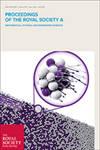Navier-Stokes方程的通量雅可比矩阵平方和的旋转变换
Proceedings of the Royal Society of London. Series A. Mathematical and Physical Sciences
Pub Date : 2004-12-08
DOI:10.1098/rspa.2004.1365
引用次数: 0
摘要
我们报告了对模拟粘性可压缩气体流动的Navier-Stokes方程的一个新的数学恒等式的发现。恒等式涉及旋转坐标系中粘性通量雅可比矩阵的平方和,并采用非常紧凑的相似变换形式:∑i=1 3a * id =G{∑i=1 3a * id a id} G T。欧拉通量雅可比矩阵平方和的一个类似关系的证明出现在Venkatasubban (Proc. R. Soc)中。Lond。(2001) 457, 1111-1114)。当时,对Navier-Stokes方程的扩展还不明显,因为这需要一个单独而详细的推导。可以注意到,这些关系具有通量雅可比矩阵本身所没有的优雅的简单性。在开发基于Navier-Stokes方程的流动求解数值算法时,在旋转坐标系中工作往往是必要的或有利的。因此,这种关系在开发用于解决空气动力学和流体动力学工业问题的纳维-斯托克斯计算机代码的新的和改进的算法方面具有潜在的应用。本文章由计算机程序翻译,如有差异,请以英文原文为准。
Rotational transformations of the sum of the squares of the flux Jacobians of the Navier–Stokes equations
We report the discovery of a new mathematical identity for the Navier–Stokes equations, which model the flow of a viscous compressible gas. The identity relates the sum of the squares of the viscous flux Jacobians in rotated coordinate systems, and takes the form of a remarkably compact similarity transformation: ∑ i=1 3 A * i d =G{ ∑ i=1 3 A i d A i d } G T . The proof of an analogous relationship for the sum of the squares of the Euler flux Jacobians appeared in Venkatasubban (Proc. R. Soc. Lond. (2001) A457, 1111–1114). At that time, the extension to the Navier–Stokes equations was not evident, given that this requires a separate and detailed derivation. It may be remarked that these relationships possess an elegant simplicity that the flux Jacobians themselves do not have. In developing numerical algorithms for flow solvers based on the Navier–Stokes equations, it is often necessary or advantageous to work in a rotated coordinate frame. This relation thus has potential applications in the development of new and improved algorithms for Navier–Stokes computer codes used to solve industrial problems in aerodynamics and fluid dynamics.
求助全文
通过发布文献求助,成功后即可免费获取论文全文。
去求助
来源期刊
自引率
0.00%
发文量
0
期刊介绍:
Proceedings A publishes articles across the chemical, computational, Earth, engineering, mathematical, and physical sciences. The articles published are high-quality, original, fundamental articles of interest to a wide range of scientists, and often have long citation half-lives. As well as established disciplines, we encourage emerging and interdisciplinary areas.

 求助内容:
求助内容: 应助结果提醒方式:
应助结果提醒方式:


